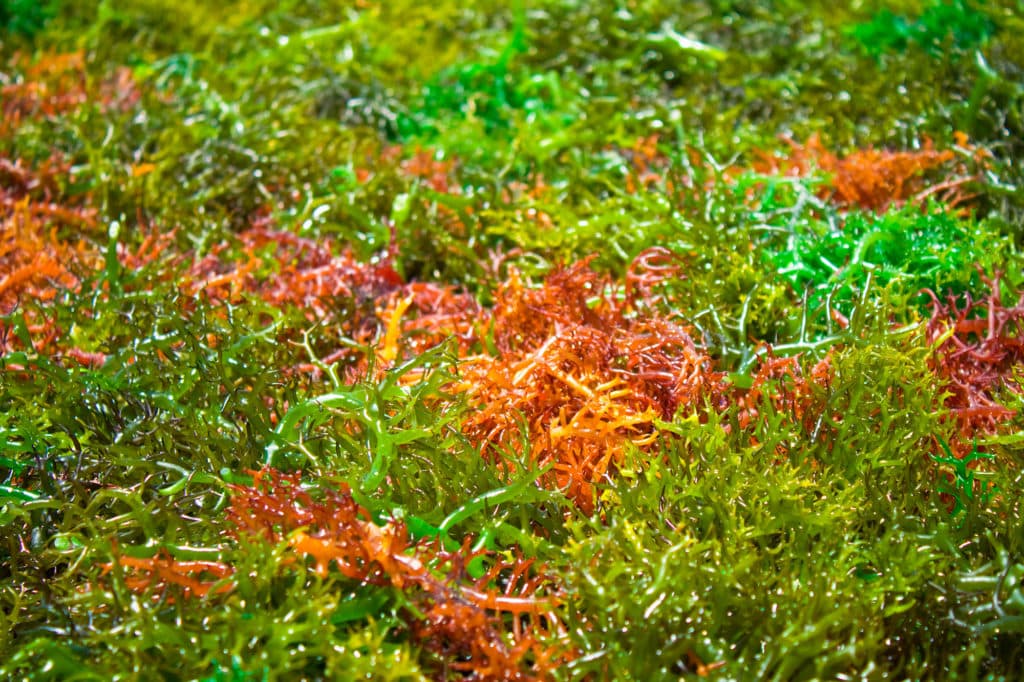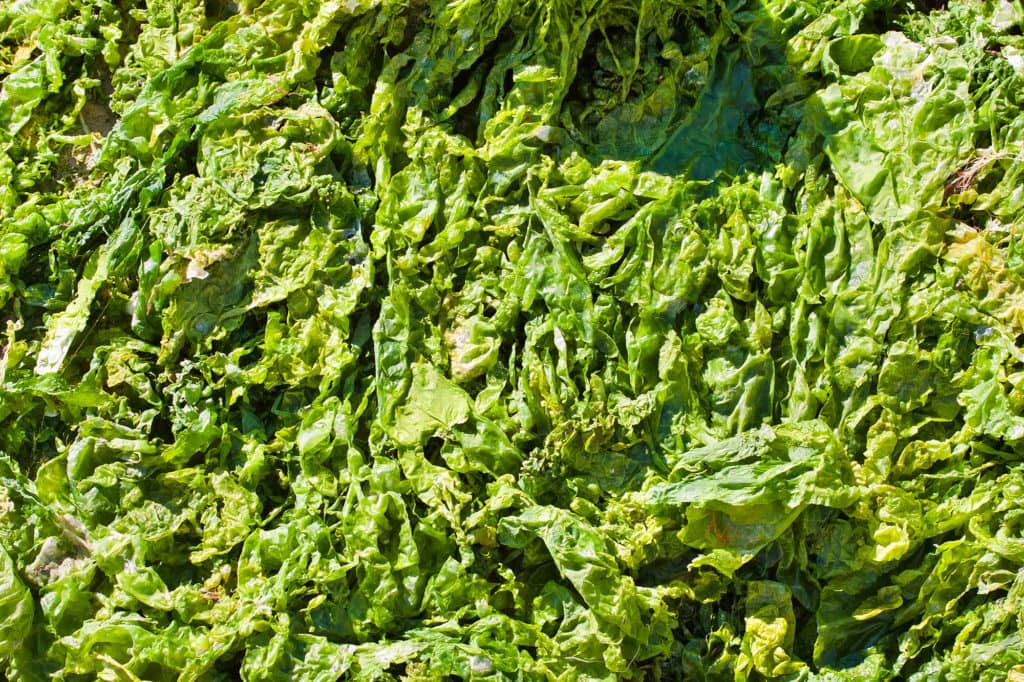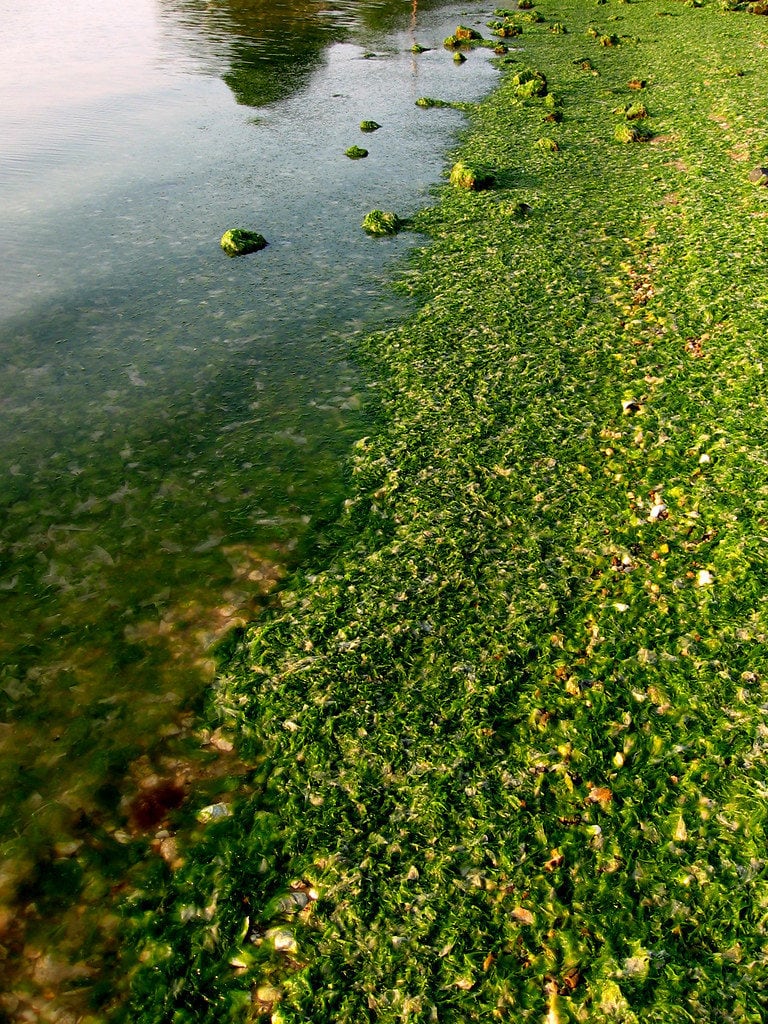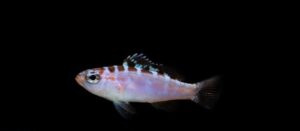Macroalgae is a large type of algae that is mostly beneficial and is used mainly to fight nutrient levels and microalgae growth. It is most commonly found in refugiums in the sump area of a tank. Unlike GFO or protein skimming, using microalgae to combat algae growth and nutrient export is completely natural and cheap. It is also simple to use and care for. It is not a coincidence that tanks with minimal algae growth also use macroalgae. If anyone needs a solution to algae growth and high nutrient levels that is cost efficient, simple, and effective, they should most definitely consider using macroalgae.
What Macroalgae Is
 The definition of macroalgae is large algae that often lives in dense groups. Do not confuse macroalgae with microalgae, as they are very different. Microalgae grows as a film or layer often on the glass and rocks in an aquarium. This is the type of algae that hobbyist are always battling at its rapid rate of growth. On the other hand, macroalgae is generally algae that hobbyist will grow in their sumps in attempt to get rid of the microalgae. Unlike microalgae, macroalgae does not grow at fast, uncontrollable rates. There are generally three groups or types of macroalgae: red macros, green macros, and brown macros. Some common kind of macroalgaes are Chaetomorpha (Chaetomorpha linum), Sea lettuce (Ulva lactuca), and Pom Pom Gracilaria (Gracilaria hayi), all of which are available at algaebarn.com. Each have their individual pros, but they all have the common effect of using up and getting rid of nutrients.
The definition of macroalgae is large algae that often lives in dense groups. Do not confuse macroalgae with microalgae, as they are very different. Microalgae grows as a film or layer often on the glass and rocks in an aquarium. This is the type of algae that hobbyist are always battling at its rapid rate of growth. On the other hand, macroalgae is generally algae that hobbyist will grow in their sumps in attempt to get rid of the microalgae. Unlike microalgae, macroalgae does not grow at fast, uncontrollable rates. There are generally three groups or types of macroalgae: red macros, green macros, and brown macros. Some common kind of macroalgaes are Chaetomorpha (Chaetomorpha linum), Sea lettuce (Ulva lactuca), and Pom Pom Gracilaria (Gracilaria hayi), all of which are available at algaebarn.com. Each have their individual pros, but they all have the common effect of using up and getting rid of nutrients.
[macroalgae]
How Macroalgae Slows Algae Growth
First, you need to understand the central cause for extensive algae growth within the saltwater aquarium. The answer is simple: high nutrient levels. These nutrients are like food for the algae, so when there is a surplus of these nutrients, such as nitrate and phosphate, the algae is able to take over the aquarium and devour the rocks. Macroalgae is algae too and also uses nutrients as a form of energy intake. That being said, when macroalgae is in a reef system it is effectively “steeling” the microalgae or bad algae’s food. Macroalgae is natural competitor for these nutrients and is capable to out compete the microalgae for nutrients.
Chaeto
Chaetomorpha is the most referred to algae as macroalgae within the hobby. It is also the most common macroalgae found in reef systems. Aside from being a very functional nutrient export, Chaeto is also used as a habitat for copepods in refugiums. It is very dense in a tangled bush like from, which allows it to be an operative breeding place for copepods, amipods, and other like organisms. Chaeto requires some flow and a light source. This could be done in a refugium or even a “Chaeto reactor”. A Chaeto reactor is just a normal media reactor with a light strip wrapped around it. It could be used on smaller tanks or tanks without refugiums. It serves the same purpose to eliminate nutrients in the water.
Sea Lettuce
Tilted as the fastest growing macroalgae, Sea lettuce (Ulva lactuca) is an alternate option to Chaeto. It has the same benefits that Chaeto has and more. Like other macroalgaes, Sea lettuce is useful in removing unwanted nutrients by consuming them. The differences is that Sea Lettuce can be used to feed herbivores such as tangs. You may get a tang to help with an algae issue in the display part of your tank, but the tang will need another sources of algae to eat when the existing algae is gone. This is where having Sea lettuce would bring great value, as you could be using it to feed the herbivores in your tank, while also exporting nutrients. Copepods and amphipods can also feed off of this macroalgae. Another benefit to adding macroalgae to a reef system is that it will also stabilize Ph parameters.
Sea lettuce does require increased levels of bright light. If you decide to purchase Sea lettuce, you will want to be sure that your refugium has a viable light to support the fast growth rate of this macroalgae.
Pom Pom Gracilaria
Being one of the most beautiful macroalgaes, Pom Pom Gracilaria is yet another option for macroalgae in your reef system. As it is one of the better looking macros, you can easily find a way to fit it into the display part of your system. Like the other macros, Pom Pom Gracilia is capable of nutrient export. It is the least effective in doing so, but it will certainly help whether it is being used alone or in combination with another kind of macroalgae. Putting this type of algae into your display tank can add an additional natural beauty to it with its vibrant red algae color.
Macroalgae in a Refugium
The most common place for macroalgae to be used is in the refugium of a saltwater aquarium. In fact, the macroalgae will be the center part of the refugium. In order for the algae to grow properly, you will want to be sure that it is living under the correct conditions. Be sure that the light you are using is sufficient for the algae your are growing. Note that some algaes require more light than others and some prefer less light than others. Like everything else in this hobby, it is important to do in depth research on the type of alage you will be caring for. You will also want to research the light period for specific alages. Generally, refugium lights are set on timer to turn on the opposite that of which the display tank’s lights are set to turn on. After you have the lighting portion settled out, it is important to have the refugium in the correct location of the sump. I recommend having your refugium be the last section of filtration of the sump. This way any copepods that are living in the sump do not have to go through any filter media, skimmer, or other filtration before getting to the display tank. Having the refugium last will also increase the efficiency at which the macroalgae stabilizes the Ph levels.
As always, there is never an end to research, but the information in this article should give you an idea of the different types of macroalgae and which one is best for you. Enjoy seeing the great affects of macroalgae and happy reefing.
[macroalgae]






Nelly Acevedo says
Thank for such helpful information
kelli.hoefler says
thanks for the helpful information. Im setting up a new tank and will be adding to my monthly subscription.
Alex says
Very helpful information
Danny says
I’m trying the external algae scrubber for my new Red Sea 350. Let’s see how it goes.
Kenneth Showman says
Thanks for all the useful information. I love that there is so much helpful information to go along with all of the high quality products you guys offer.
dkwash76 says
This has such useful information I cannot wait to get started my sump and refugium.
Presto2345 says
Rather do natural than chemical.
Duane Washington says
I’m so excited to get started setting up my refugium
multanemo says
Can you use the Ocean Magik beyond the “good by” date of about a month?
greg.chernoff says
While we do suggest use by 30 days, I have seen our phyto go much longer without turning! It will smell like sulfur really badly if it is no longer any good, so don’t forget to give the bottle a smell before putting any into the tank!
multanemo says
Can you use the Ocean Magik beyond the “good by” date of about a month?
Andrew Bilodeau says
True that!
Megan says
This makes an awesome read for beginners!!
sally dolly says
I Love all of the information Algaebarn provides. I also love getting my supplies,pods and inverts from them! Everything is always first class with this company.
Gino Vanaria says
What’s a good amount of pods to add to a 40 gallon mixed reef with 1 four strip damsel a pair of Clowns a Midas Blenny a Cleaner Shrimp and thinking of adding a six line Wrasse or Mandarian.
Should I add pods weekly, I weekly, monthly? Directly in tank or in filtration area? I have an all in one tank with some chaeto in one of the chambers in the filtration area (begins the actual tank). It’s the Cobalt C Vue 40 so you could see what I’m talking about exactly. Thanks a lot! God bless!
greg.chernoff says
If you seed your tank before adding any major pod eaters, it will likely be far better for your tank, and the eventual mandarin or six line! I would suggest 1-2 jars a month for 3-4 months to really provide a large number of breeding age copepods!
mamucher says
Thanks!
Aaron Sutton says
Thank you for the great info and awesome products!
Hannah says
Thank you for all of the helpful information!
Scott Schimmel says
Setting up a new 90 gallon reef with a 30 gallon sump and it plan on starting it out with the Ultimate Refegium Starter Pack
James kuchelmeister says
This is amazing info
bmeister44 says
Chaetomorpha in the refugium with a Prime Fug light is amazing!
Chris G. says
Information is much appreciated.
Diana says
You have the best pods on the internet!
Krystina Coyne says
All this information is so helpful. Really excited with starting up my new refugium
jamesdylanmccraw says
Thanks for the info on macro algae was wondering
pdeolim says
Thank you for changing the reefing game forever!
David Oreol says
Interesting article, but it needs to be proofread.
Jon Trafton says
Good info
will says
thanks for the info!
Deanna says
great info. loved mt pods
jackrudisill says
Great information and products. Thank you. The sea lettuce has been producing like crazy. It is helping with overnight PH stabilization and nutrient control.
David Belle says
Great quality and fast delivery
Emily Long says
Great info on maxroalgea.
Gary Henkel says
i’m commenting on your blog post
Tanya BAZALDUA says
Great Information
MIKE HUDSON says
Thanks for your information on your website. Your advice has helped me with all 3 of my saltwater tanks. Even down to the last critter cleaner to keep my tank balanced and the water quality extremely good!! Great website.!! Mike
fierogt says
Great information!
AP says
Great quality products — I’ve never been disappointed with an order.
RR says
Bought some Chaeto a couple years ago. After 6 months I had to start throwing out a five gallon buckets worth every other month. Great nutrient export, just wish I could get all the pods out.
Brent reiser says
The best pods I’ve found yet! Fast breeders!!!
Douglas Campbell says
I’m looking to set up macroalgae in my refugium soon will be using algaebarn for sure
mike shaw says
Great information for a beginner to the hobby
Kyle says
I love algaebarn!!!!!
Paul says
I just learned that Sea Lettuce can be used in the sump and then fed to my Tangs… I knew my Tangs would eat it, but I didn’t realize it would be good in the Refugium. I’ll have to give that a try!
Andy says
Everybody needs pods!
Ashleigh Coombs says
Love the AlgaeBarn! Such great products and prices, shipping is top notch!
Robert says
I’m getting something for the display
Geofrey Shu says
Best Chaeto out there to buy! Love the pods too. Thanks!
Cole presley says
Super helpful and great info
E says
Thanks for sharing the vital informatioN!
James McBryde says
Excellent information!
Nelly Acevedo says
I need so much help with this
James McGilvray says
I grow both Chaeto and Sea Lettuce.
Austin Byers says
Won’t ever have a tank without this stuff
Karl Halmstad says
great info for anyone needing help on these products
Sage Cowley says
Chato is my jammy.
Drew Pearce says
Awesome!
trevor says
Great article, thank you for this!
Jerry L Thompson says
Thanks for the info
B Luke says
Such great products! Thanks for all the useful information!
brandonbjones1 says
Do cheato need a special light or can it grow without light and how often you supposed to change it?
Kenneth O Thomas says
I’m getting something for the display
Sarah says
Macroalgae has helped my water quality immensely!
Duy Le says
Natural is always better than chemical
Rob Colletti says
Refugium for the win in nutrient export!
Jose Pacheco says
Nice info, thanks
Cassidy says
My first shipment comes in two days!
Peter Cassidy says
Time for some chaeto!
jeff5 says
Very, very helpful for sure! Always awesome reading your articles!
Jose Pacheco says
Nice info. Thanks.
Jose Pacheco says
I don’t have protein skimmer but I have cheato and sea lettuce in my refugium and really help me whit algae in my tank, is more better and natural than gfo.
xylahilton says
Are there ways to introduce macroalgae to the main aquarium like maybe in some type of basket?
Mike Mijarez says
Refugium!!
JA says
Very informative! Thanks!
Renee says
X?
Ellen S Imbrie says
Thanks
sdemarco62 says
I have chaeto in my sump with my live rock
Dee Oxendine says
I’m glad o found coralFish12g… love the information
Jeremy Hunsberger says
Love the info!
John Evans says
Very informative! Thanks!
William Ware says
Really need to get some macro algae setup in my tank and sump.
Renee says
Interesting, thank you!
Jerry Foster says
good read
I’m looking into nutrient export as I don’t run a skimmer and can’t do a sump
Terry says
Natural filtration is best and more natural.
Danzel Thad Ermac Boiser says
This is very helpful especially to us beginners as it gives us knowledge on what to put in our first refugium. Thank you very much!
Anthony J Szurek says
I love the 5280 pods.
Jon B Swetnam says
Very useful information. We use a lot of macro algae!
Eric Serrano says
I would love more microalgae to help bring nitrate down
David Cawley-cole says
Great read.
Rhonda Cunningham says
I’m a saltwater newby. You guys put out some very helpful info. Thanks!
Remy Lelias says
I think that macro algae is essential for a successful reef creating habitats for microorganisms and removing nitrates.
Doug Talley says
Is there a such as too much algae in your refurgium?
Remy Lelias says
i’m going to get some for my reef tank. it helps with biodiversity and with nutrient issues.
Sean says
Looks like I need to get more Macro.
Nathaniel Konkel says
What about other macro algaes like caulerpa racemosa? Are those recommended at all?
Vancjj says
Supper huge fan of using macro in my reef system and my sump is bigger then my DT just for the macros. Awesome article thanks.
smash2799 says
Sweet articel!!!
James Adams says
A buddy of mine wants to try this I’m interested.
simonssymfony says
very informative
Jose Pacheco says
Nice info, thanks algae barn!!!
fishtankpsycho says
I will never run a tank without chaeto ever! Best filtration asset a tank can have.
Katherine Lawrence says
Great info!
chell S. says
Love the PomPom macro (Gracilaria Hayi). It really adds color to a tank!
Brendan says
Excited to start growing some chaeto.